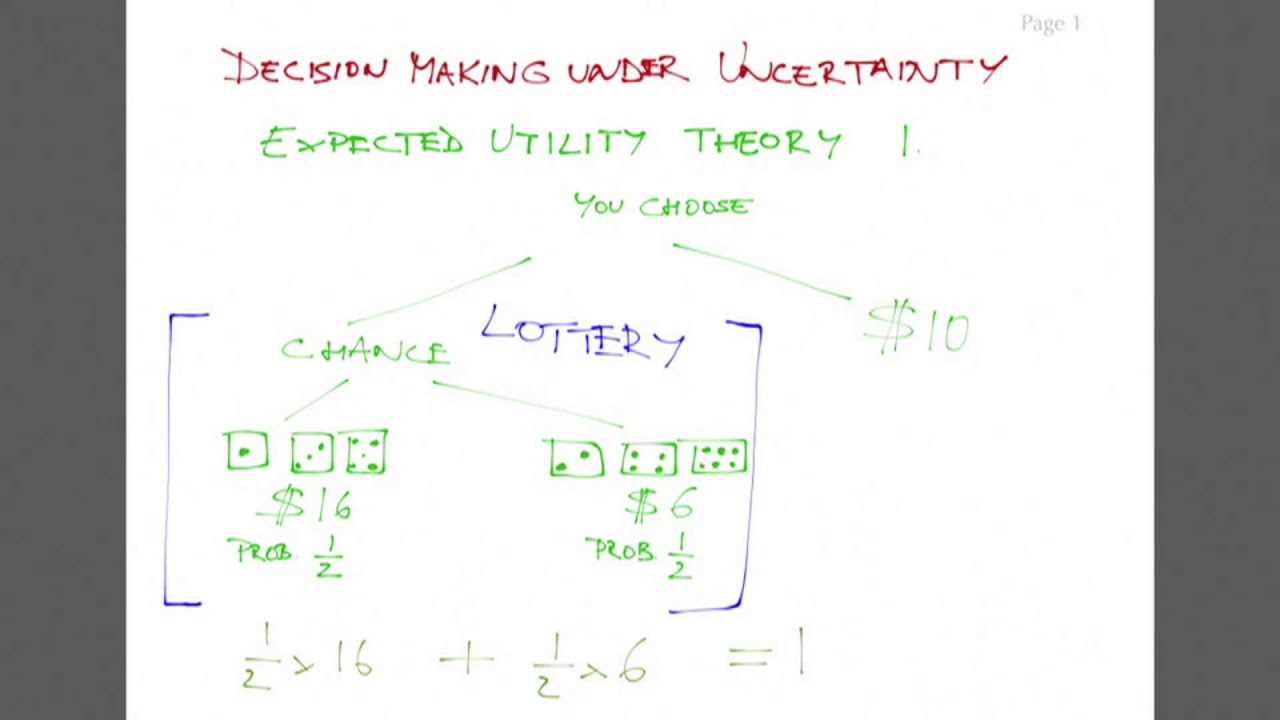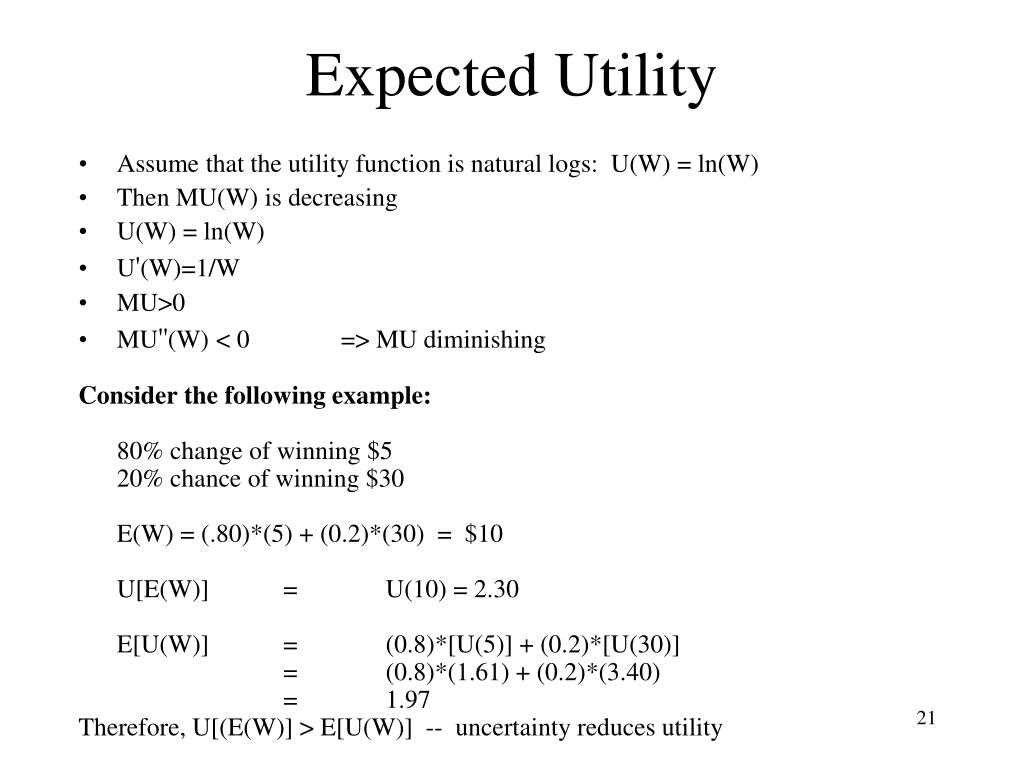Expected Utility Definition
Expected utility is a concept in economics that measures the value or satisfaction an individual or entity expects to gain from a particular decision or choice. It is based on the idea that individuals make decisions by weighing the potential outcomes and their associated probabilities.
The expected utility theory assumes that individuals are rational decision-makers who seek to maximize their overall well-being or utility. Utility is a subjective measure of satisfaction or happiness, and individuals aim to choose options that will maximize their expected utility.
To calculate expected utility, one must consider the possible outcomes of a decision and assign probabilities to each outcome. The utility of each outcome is then multiplied by its probability and summed together to obtain the expected utility.
Overall, expected utility is a fundamental concept in economics that helps analyze decision-making processes and understand how individuals weigh risks and rewards when making choices.
What is Expected Utility?
Expected utility is a concept in economics that measures the value or satisfaction an individual or entity expects to receive from a particular outcome or decision. It is used to make rational choices and decisions under conditions of uncertainty.
Expected utility theory assumes that individuals are rational decision-makers who seek to maximize their overall well-being or utility. Utility refers to the subjective value or satisfaction that an individual derives from consuming goods or experiencing certain outcomes.
The concept of expected utility takes into account both the probabilities of different outcomes and the individual’s preferences or attitudes towards those outcomes. It allows individuals to weigh the potential benefits and risks associated with different choices and make decisions that maximize their expected utility.
Calculation of Expected Utility
To calculate expected utility, one must assign subjective utility values to different outcomes and multiply them by the probabilities of those outcomes occurring. The formula for calculating expected utility is as follows:
Expected Utility = (Utility of Outcome 1 * Probability of Outcome 1) + (Utility of Outcome 2 * Probability of Outcome 2) + … + (Utility of Outcome n * Probability of Outcome n)
By assigning utility values to different outcomes, individuals can express their preferences and attitudes towards those outcomes. These utility values can be subjective and vary from person to person.
Examples of Expected Utility
Expected utility can be applied to various decision-making scenarios. For example, when deciding whether to invest in a particular stock, an investor may consider the potential returns and the associated risks. By assigning utility values to different potential outcomes (e.g., high returns, moderate returns, or losses) and multiplying them by the probabilities of those outcomes occurring, the investor can calculate the expected utility of the investment decision.
Expected utility can also be used in personal decision-making, such as choosing between different job offers or deciding whether to pursue higher education. By considering the potential benefits and risks of each option and assigning utility values to different outcomes, individuals can calculate the expected utility of their choices and make informed decisions.
In summary, expected utility is a concept that allows individuals to make rational decisions under conditions of uncertainty. By assigning utility values to different outcomes and considering their probabilities, individuals can calculate the expected utility of different choices and make decisions that maximize their overall well-being or satisfaction.
Calculation of Expected Utility

Expected utility is a concept used in economics to measure the satisfaction or value that an individual or decision-maker expects to receive from a particular outcome or set of outcomes. It is calculated by multiplying the utility or satisfaction associated with each outcome by the probability of that outcome occurring, and then summing up these values.
To calculate the expected utility, you need to follow these steps:
Step 1: Assign Utility Values
First, you need to assign utility values to each possible outcome. Utility is a measure of the satisfaction or value that an individual derives from a particular outcome. It is a subjective measure and can vary from person to person. For example, if you are considering the outcome of winning a lottery, you might assign a utility value of 10 to represent the high satisfaction you would derive from winning.
Step 2: Assign Probabilities
Next, you need to assign probabilities to each possible outcome. Probabilities represent the likelihood or chance of each outcome occurring. These probabilities should add up to 1. For example, if you are considering the outcome of winning a lottery, you might assign a probability of 0.01 to represent the low chance of winning.
Step 3: Multiply Utility by Probability
Once you have assigned utility values and probabilities to each outcome, you need to multiply the utility of each outcome by its corresponding probability. This gives you the expected utility for each outcome. For example, if the utility of winning the lottery is 10 and the probability of winning is 0.01, the expected utility of winning would be 0.1.
Step 4: Sum up the Expected Utilities
Finally, you need to sum up the expected utilities of all possible outcomes. This gives you the overall expected utility for the decision or set of outcomes. For example, if you have multiple outcomes with their respective expected utilities, you would add them together to get the total expected utility.
The calculation of expected utility allows decision-makers to compare different options and make rational choices based on their preferences and the probabilities of different outcomes. By considering both the utility and probability of each outcome, individuals can make more informed decisions that maximize their expected satisfaction or value.
Examples of Expected Utility
Expected utility is a concept used in economics to measure the value or satisfaction an individual or decision-maker expects to derive from a particular choice or outcome. It takes into account both the probability of different outcomes and the individual’s preferences or utility function.
Here are some examples to illustrate the concept of expected utility:
Example 1: Suppose you are considering two investment options: Option A and Option B. Option A has a 70% chance of earning a profit of $10,000 and a 30% chance of earning a profit of $0. Option B has a 50% chance of earning a profit of $5,000 and a 50% chance of earning a profit of $2,000. To calculate the expected utility, you would assign a utility value to each outcome based on your personal preferences. For example, you might assign a utility of 0 to earning $0, a utility of 10 to earning $10,000, a utility of 5 to earning $5,000, and a utility of 2 to earning $2,000. The expected utility of Option A would be calculated as (0.7 * 10) + (0.3 * 0) = 7, and the expected utility of Option B would be calculated as (0.5 * 5) + (0.5 * 2) = 3.5. Based on these calculations, you would choose Option A because it has a higher expected utility.
Example 3: Imagine you are deciding between two job offers: Job A and Job B. Job A offers a higher salary but requires longer working hours, while Job B offers a lower salary but shorter working hours. To determine the expected utility of each job offer, you would need to consider your personal preferences for salary and leisure time. For example, if you value leisure time more than salary, you might assign a higher utility value to Job B. Based on your preferences and the probabilities of different outcomes, you can calculate the expected utility of each job offer and make a decision accordingly.
These examples demonstrate how expected utility can be used to make rational decisions by taking into account both the probabilities of different outcomes and individual preferences. By calculating the expected utility of each option, decision-makers can choose the option that maximizes their expected satisfaction or value.
Economics and Expected Utility
In the field of economics, expected utility theory is a fundamental concept that helps economists understand and analyze decision-making under uncertainty. It provides a framework for individuals to make rational choices based on their preferences and the potential outcomes of different actions.
Expected utility theory is based on the idea that individuals assign subjective values, or utilities, to different outcomes. These utilities represent the individual’s preferences and reflect their level of satisfaction or happiness associated with each outcome. The theory assumes that individuals are rational decision-makers who seek to maximize their expected utility.
Utility and Decision-Making
Utility is a measure of the satisfaction or happiness that an individual derives from consuming goods or experiencing different outcomes. It is a subjective concept and varies from person to person. In economics, utility is typically represented by a utility function, which maps different levels of consumption or outcomes to corresponding utility values.
When faced with a decision under uncertainty, individuals evaluate the potential outcomes based on their expected utilities. The expected utility of an outcome is calculated by multiplying the utility of each possible outcome by the probability of that outcome occurring, and then summing up these values. This allows individuals to compare and rank different choices based on their expected utilities.
Application of Expected Utility Theory

For example, expected utility theory can help explain why individuals may choose to invest in risky assets with higher expected returns, even though they are exposed to the possibility of losses. It also provides insights into how individuals make choices in situations involving uncertainty, such as insurance decisions or career choices.
Furthermore, expected utility theory has implications for public policy and welfare analysis. Policymakers can use the concept of expected utility to evaluate the potential benefits and costs of different policy options and make decisions that maximize overall societal welfare.

Emily Bibb simplifies finance through bestselling books and articles, bridging complex concepts for everyday understanding. Engaging audiences via social media, she shares insights for financial success. Active in seminars and philanthropy, Bibb aims to create a more financially informed society, driven by her passion for empowering others.
